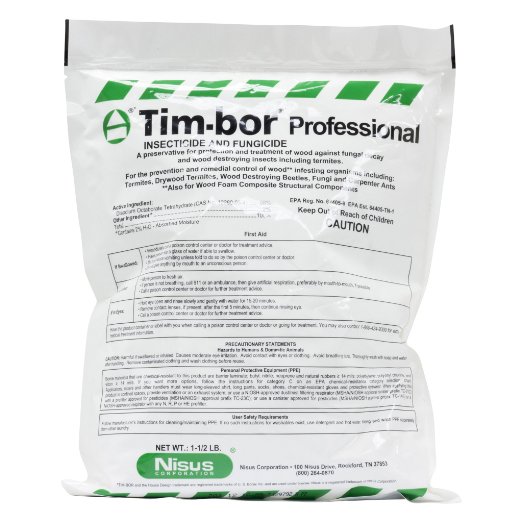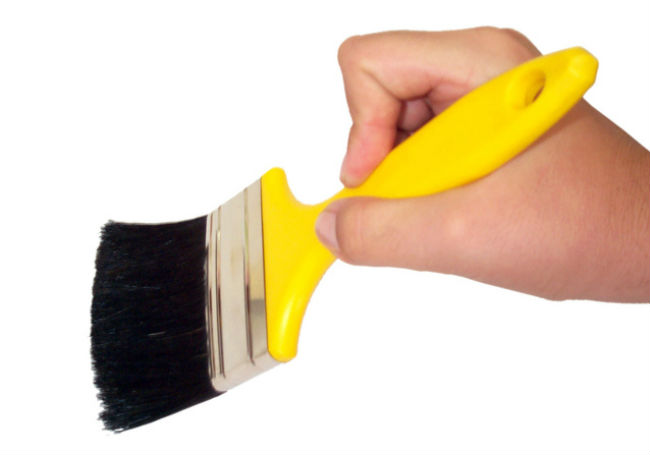Drywood termites are found from NC along the southern boarder of the USA and the coast of California northward to the San Francisco Bay area. They start their colonies in pre-existing openings in wood with low moisture level. Due to the fact that they live entirely in wood pieces, diy Timbor for drywood termites can help the most homeowners in the USA and Australia wipe out these destructive pests.
Timbor vs glycol-based borates for drywood termites
In fact, diy Timbor for drywood termites was specially designed for preventive treatment. This borate product penetrates only 1/4 inches deep into wood, which is not sufficient for their elimination. In order to get rid of drywoods, it is better to apply more concentrated glycol-based borax derivatives, such as Bora Care, Shell Guard or Jecta gel. They penetrate the wood structure deeper and saturate it about 4 inches from any side.
Borates with glycol are ideal for eliminating active drywood termite infestations. Pest control professionals can treat all available wood wherever termite activity is observed. Walls and voids can be drilled and injected with high pressure mist, gel or foam of boric acid. Crawl spaces and any other zones with infested wood are also treated with glycol boric acid products.
Diy Timbor for drywood termites application
Timbor is a professional product. It can be purchased by pest control professionals with license. Though, the homeowners often buy Timbor termicide on ebay and amazon to perform treatment on their own. This treatment helps them save a great deal of money, though this process is not so easy as it may seem at first.

In order to apply diy Timbor for drywood termites, you must read the product label[ref]Tim-Bor label, p.3-4[/ref] carefully and follow it as directed. Do not forget about your personal protective equipment (for Category C) to prevent from skin or eye irritation, accidental inhalation or swallowing the chemical product.
This table contains all the necessary information about the borate powder Tim-bor Professional for control of termites diy| Product: | TIM-BOR Professional |
|---|---|
| Chemical name and family: | Disodium Octaborate tetrahydrate (DOT) inorganic borates |
| CAS reg. No: | 12280-03-4 |
| EPA reg. No: | 64405-8 |
| Manufactured by: | Nisus Corporation |
| Active ingredient: | 98% disodium octaborate tetrahydrate |
| Description: | a white, fluffy powder, sold in 1.5 lb bags, boxes with 8x1.5 lb bags, 25 lb buckets |
| Product properties: | insecticide fungicide wood preservative |
| Target pests: | Wood-destroying insects: Subterranean Termites (Reticulitermis, Coptotermes or Formosan, Heterotermes) Dampwood Termites (Zootermopis) Drywood Termites (Kalotermes, Incisitermes) Ants Beetles (Powderpost, Borers, False borers, Furniture) |
| For use in: | 1. all types of lumber, plywood or logs. 2. indoors and outdoors 3. for remedial control and wood protection |
| Not suitable for: | 1. wood that has been vanished, sealed or painted 2. exterior areas that are subject to excessive rain |
| Not for sale to: | NY CT |
| Application form: | 1. coatings with foam and liquid solution. For the best results, apply to bare wood 2. in-structure injections with liquid solution, dust and foam. Pre-drilling is required. |
| Product mixing: | 10% dilution: 1 pound of powder + 1 gallon of water 15% dilution: 1.5 pounds of powder + 1 gallon of water 15% foam: 1.5 pounds of powder + 1 gallon of water + 1-2 ounces of foaming agent |
| Application rate: | Timbor coverage depends on the formulation: 1) 1 gallon of finished dilution (1.5 lb bag) per 250 sq. ft of wood surface area 2) 0.5 oz of powder per 1 sq.ft 3) 1 gallon of Timbor dilution produces 20 gallons of dry foam per 250 sq. ft |
| Application mode: | 1. Apply 10% solution for dry wood 2. Apply 15% foam of solution for wood of high and normal moisture level 3. Apply in the form of bare wood coating 4. Drill and apply in the form of injections into wall voids and inside galleries |
| PPE (personal protection): | Category C on the EPA chemical resistance category selection chart. 1. long-sleeved shirt long pants 2. closed shoes with socks 3. chemical resistant gloves 4. protective eyewear 5. respirator (in confined space) |
Timbor is sold in powder formulation, which should be diluted with water for mixing liquid solution or foam. For drywood termites, it is recommended the homeowners to apply 10% Timbor finished liquid to bare wood and structures, including fences, decks, barns, walls and others. When you mix it, use water in a 1:1 ratio for the best results. It means, 1 pound of Timbor powder must be dissolved in 1 gallon of water.

Timbor liquid solution against drywood termites diy
For remedial control and protection against drywood termites, two applications of 10% Tim-bor solution are required. Take a paint brush and coat or brush the liquid borate on the wood surface. Dry wood absorbs DOT liquid easily, though it has a drawback: borate leaves a whitish residue on the surface after it dries. This coating will break down in just a few years and will prevent your home from termite attacks and any future damage. It is necessary to protect the treated structure from excess rain and moisture.
You can also drill holes in the walls and wood structure in 4 ” pattern at a downward angle. Inject 10% Timbor liquid under pressure into the drill holes, openings and cracks in wood, until run-off is observed coming from exit holes.
Application of Timbor dust for drywood colonies diy
Diy Timbor for drywood termites treatment can also include application of Timbor powder. Dust can be injected into galleries and voids at application rate of 1 oz per 2 sq. ft. Note that penetrating properties of powder are limited and its coverage area is reduced. Too much dust can seal or plug the termite galleries, and drywood nymphs that act as workers and soldiers, just isolate these areas and won’t use them for their purposes. Tim-bor powder can be also applied for coating the wood surfaces for preservation.
You say must be used in a 1:1 ratio timbor powder to water. Then you say 1 lb. to 1 gallon
Well one ob is 454 grams….and a gallon is approximately 4000 grams…hardly a one to one ratio.!